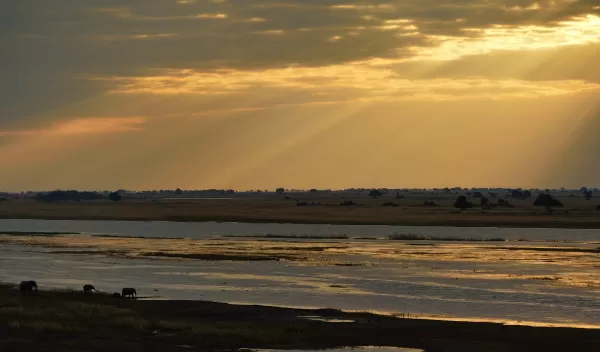
Land cover change in Botswana savannas: Don't blame the elephants
Find related stories on NSF's Environmental Research and Education (ERE) programs at this link.
Why are drylands changing in the Chobe district of Northern Botswana? A new study tracks differences in the savanna there across 30 years, and provides information that will allow governments and non-profit organizations to improve dryland management strategies in the region.
The findings show little support for notions that elephants are to blame, while human-caused fires are high on the list of reasons.
The results are published in Arid Land Systems: Science and Societies, a special issue of the journal Land.
"There is a dynamic and complex relationship among land cover types that are constantly changing," said lead author J. Tyler Fox of the University of Arkansas. "Not much is known about what happens in transitional savanna ecosystems that are located between more arid and wetter climate zones."
Added co-author Kathleen Alexander of Virginia Tech, "If we can understand how the landscape has changed over decades and what that does to water quality, human health and ecosystem health, we can begin to make predictions for the future."
The team conducted the study in Alexander's long-term field site through CARACAL, the Centre for Conservation of African Resources: Animals, Communities, and Land Use.
30 years of satellite data lead to new discoveries
The research, funded by the National Science Foundation (NSF) and Forest Conservation Botswana, examined satellite data from the past 30 years to track land cover changes in the Chobe district, a 21,000-square-kilometer area that encompasses urban, rural, communally-managed and protected lands.
"The region's savanna landscapes provide critical resources for people and other animals," said Fox. "Communities rely on forest resources such as firewood, thatch for roofs, and plants for food and medicine." The drylands are also used for tourism and for spiritual or cultural ceremonies.
"This study is one of the first to quantitatively examine the loss of forested areas and other land cover changes in savanna environments," said Richard Yuretich, program director for NSF's Dynamics of Coupled Natural and Human Systems Program, which funded the research.
"The complex relationships among climate, ecology and human activities reveal the overwhelming influence of people on the loss of woodlands," said Yuretich. "This research paves the way for effective management of these diminishing resources."
Decreasing woodlands and increasing shrublands
The scientists observed a long-term trend of decreasing woodlands and increasing shrublands. Grasslands also varied considerably over the study period. Surprisingly, the loss of woodlands tended to be greater in protected forest reserves than in the more populated Chobe District.
"We looked specifically at drought, fire and elephant disturbance as possible causes for these changes," Fox said.
Added Alexander, "Dryland ecosystems are especially vulnerable to human impacts. Domestic animals, wildlife and people congregate near scarce water resources. We're beginning to track change, identify possible drivers of that change, and follow hotspots of degradation. We can see how various stressors are affecting the land and can move to proactive rather than reactive management."
The research produced findings that run counter to some popular beliefs about environmental change. According to the scientists, many people in Botswana think that there has been a loss of trees and a change from forested land to shrubs to bare ground.
"Our data, however, reveal extensive regeneration of trees in certain areas in the right conditions," noted co-author Mark Vandewalle, also of Virginia Tech. "Change is complex and dynamic in these ecosystems."
Fires, not elephants, to blame
The team discovered that there was little evidence for holding the region's fast-growing elephant population accountable for the forest loss.
Fire, however, was a factor. Over a 13-year period, there were nearly 10,000 fires in the Chobe district. More than 85 percent occurred during a time when there were no storms or lightning; most of the fires started with human activities.
"We were able to pinpoint where and when fires were happening, which allowed us to make some fire management suggestions," Fox said. "For instance, thatch collection appeared related to fire hotspots, which extended into several of the protected forest reserves.
"These areas can be more intensively targeted for management and outreach activities. People rely heavily on natural resources extracted from the landscape and need to have sustainable access to those materials to ensure their livelihoods."
Alexander is working with the government of Botswana to develop an active monitoring approach based on the groundwork laid by this study.
"Across the globe, forest products remain an essential natural resource," she said. "We need to know the status of those resources. Long-term studies are necessary to understand system dynamics, and are fundamental to the development of improved and targeted management."
Alexander also noted that the findings have the potential to benefit dryland systems globally.
"Drylands represent more than 41 percent of the global landmass and are extremely vulnerable to human impacts," she said. "What we're learning in Botswana can be applied to other drylands that are under increasing pressure to supply human and other animal needs."


